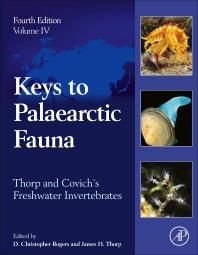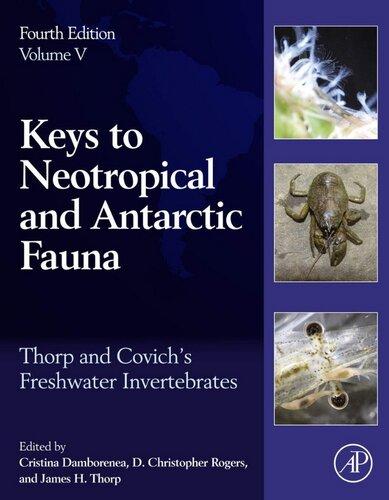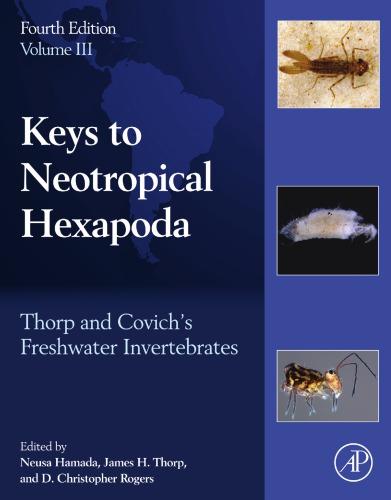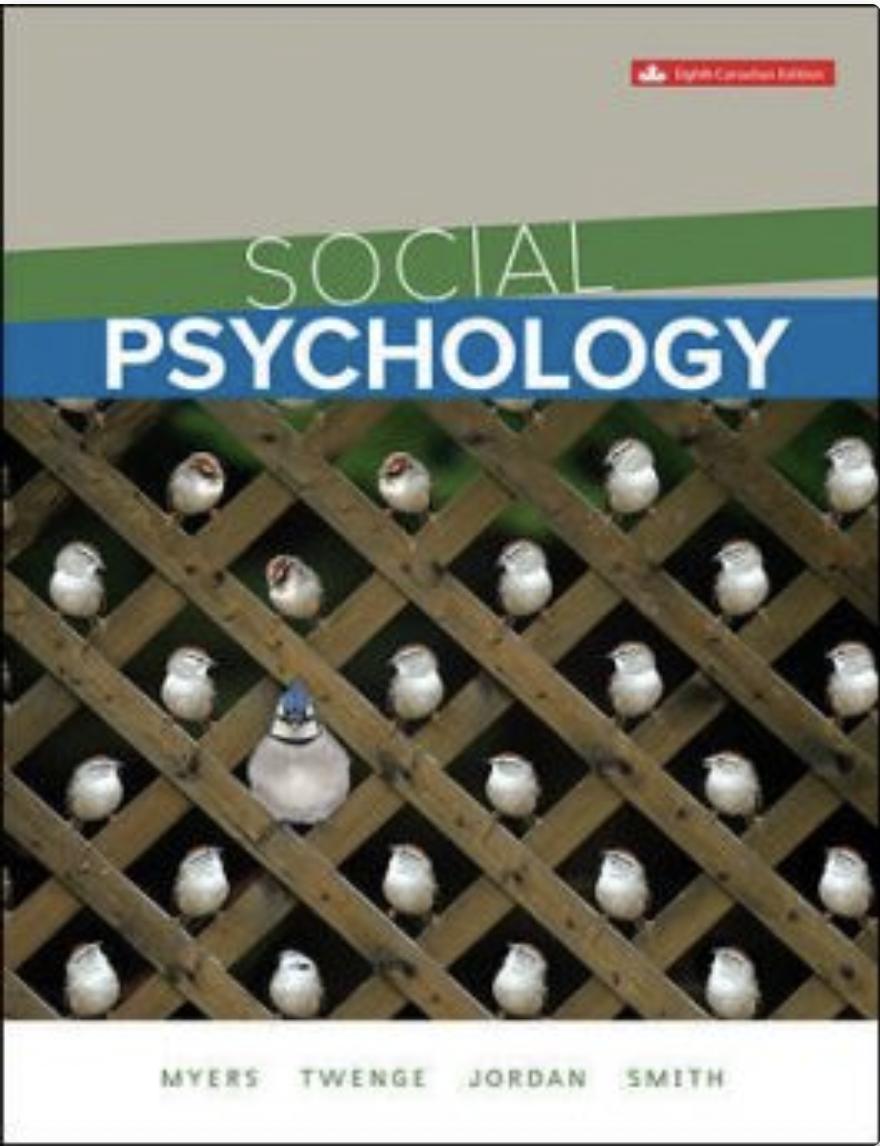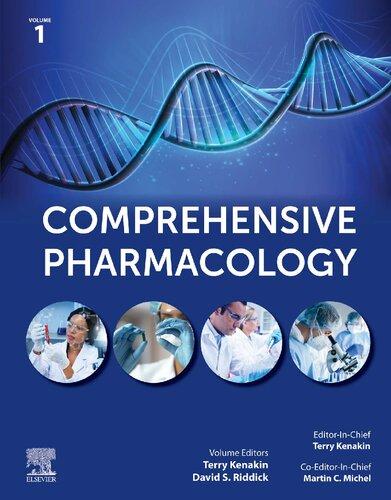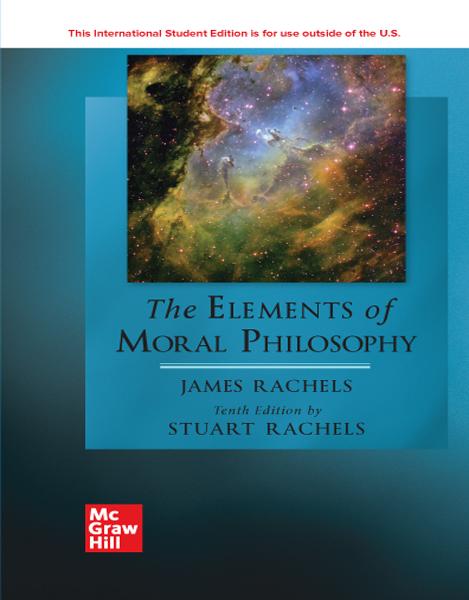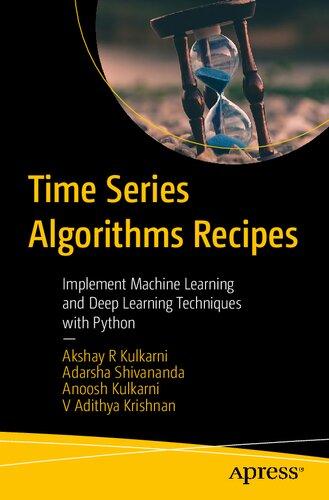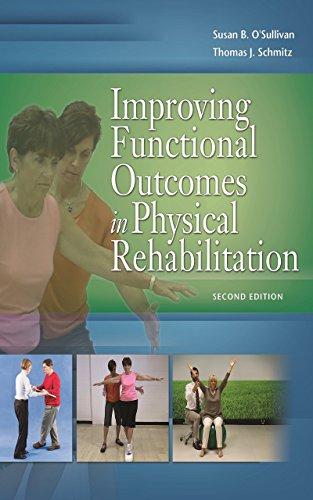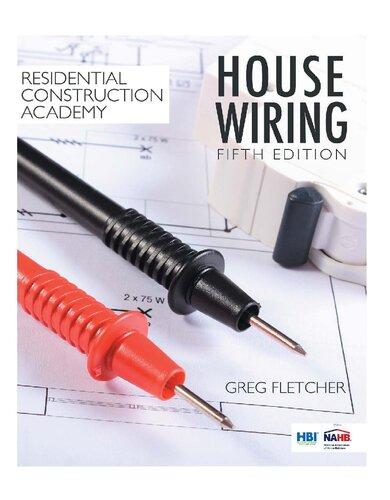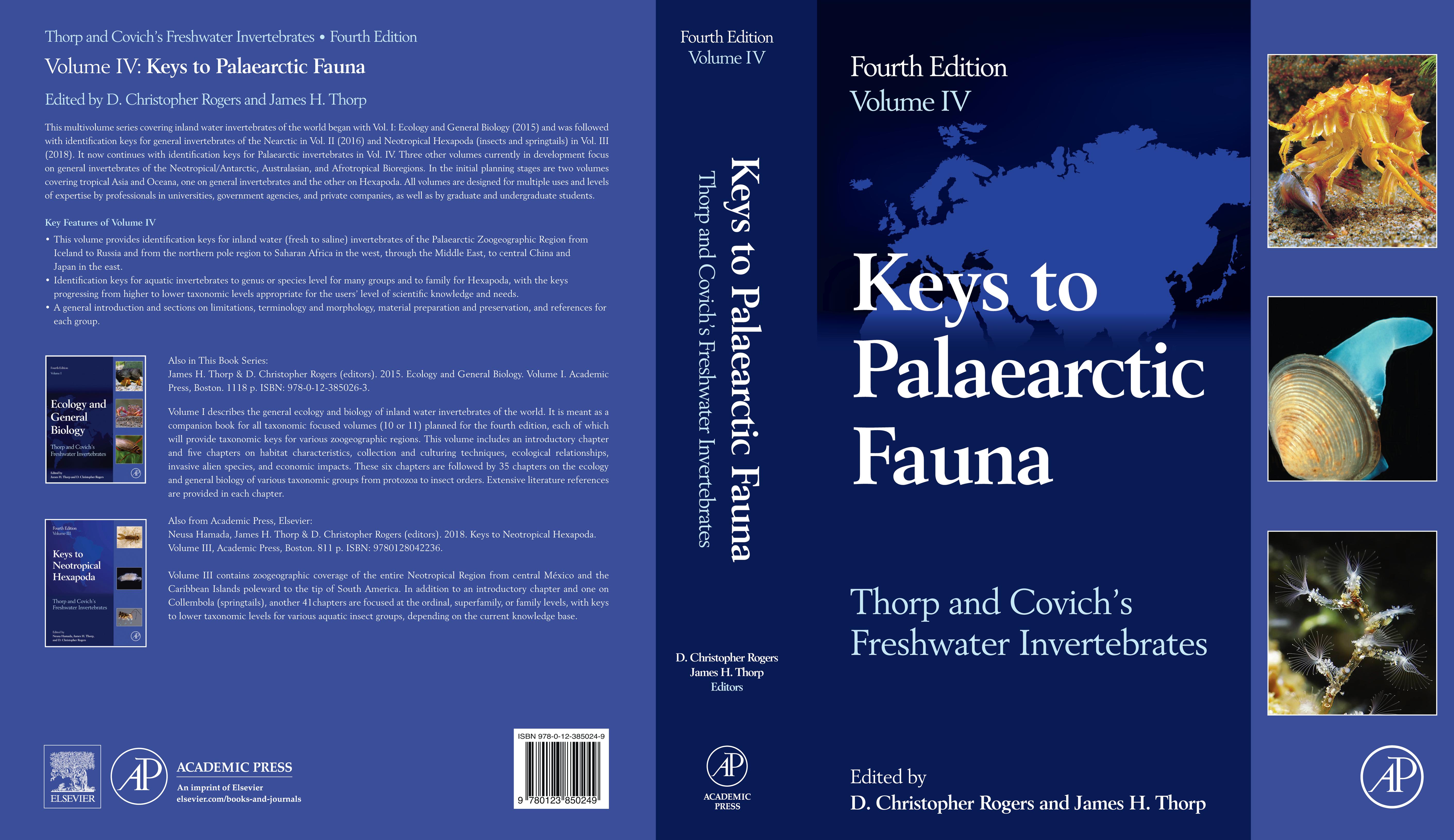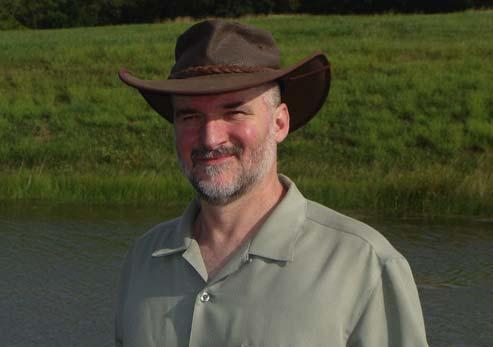KeystoPalaearcticFauna
FourthEdition
Editedby
D.ChristopherRogers
KansasBiologicalSurveyandTheBiodiversityInstitute UniversityofKansas,Lawrence,KS,USA JamesH.Thorp
KansasBiologicalSurveyandDepartmentofEcologyandEvolutionaryBiology UniversityofKansas,Lawrence,KS,USA
AcademicPressisanimprintofElsevier 125LondonWall,LondonEC2Y5AS,UnitedKingdom 525BStreet,Suite1650,SanDiego,CA92101,UnitedStates 50HampshireStreet,5thFloor,Cambridge,MA02139,UnitedStates TheBoulevard,LangfordLane,Kidlington,OxfordOX51GB,UnitedKingdom
Copyright 2019ElsevierInc.Allrightsreserved.
Nopartofthispublicationmaybereproducedortransmittedinanyformorbyanymeans,electronicormechanical,including photocopying,recording,oranyinformationstorageandretrievalsystem,withoutpermissioninwritingfromthepublisher.Details onhowtoseekpermission,furtherinformationaboutthePublisher’spermissionspoliciesandourarrangementswithorganizations suchastheCopyrightClearanceCenterandtheCopyrightLicensingAgency,canbefoundatourwebsite: www.elsevier.com/ permissions.
ThisbookandtheindividualcontributionscontainedinitareprotectedundercopyrightbythePublisher(otherthanasmaybenoted herein).
Notices
Knowledgeandbestpracticeinthisfieldareconstantlychanging.Asnewresearchandexperiencebroadenourunderstanding, changesinresearchmethods,professionalpractices,ormedicaltreatmentmaybecomenecessary.
Practitionersandresearchersmustalwaysrelyontheirownexperienceandknowledgeinevaluatingandusinganyinformation, methods,compounds,orexperimentsdescribedherein.Inusingsuchinformationormethodstheyshouldbemindfuloftheirown safetyandthesafetyofothers,includingpartiesforwhomtheyhaveaprofessionalresponsibility.
Tothefullestextentofthelaw,neitherthePublishernortheauthors,contributors,oreditors,assumeanyliabilityforanyinjuryand/or damagetopersonsorpropertyasamatterofproductsliability,negligenceorotherwise,orfromanyuseoroperationofanymethods, products,instructions,orideascontainedinthematerialherein.
LibraryofCongressCataloging-in-PublicationData
AcatalogrecordforthisbookisavailablefromtheLibraryofCongress
BritishLibraryCataloguing-in-PublicationData
AcataloguerecordforthisbookisavailablefromtheBritishLibrary
ISBN:978-0-12-385024-9
ForinformationonallAcademicPresspublicationsvisitourwebsiteat https://www.elsevier.com/books-and-journals
Publisher: CandiceJanco
AcquisitionsEditor: LouisaMunro
EditorialProjectManager: EmilyThomson
ProductionProjectManager: PaulPrasadChandramohan
CoverDesigner: GregHarris
CoverPhotographscourtesyof(fromtop): VadimTakhteev,RafaelAraujo,andGintautasSteiblys
TypesetbyTNQTechnologies
Toourauthorswhomadethisbookpossible.
D.ChristopherRogers
Tomylovingwifeofnearlyhalfacenturywhohastoleratedmyoccasional frustrationswithmyprofessionwhileshowinggreatinterestinmystudies, andtothestudentsworkinginmylaboverthedecadeswhohavenever failedtoinspireandchallengemewhilereinforcinginmymindthe truevalueofbeingaprofessor.
JamesH.Thorp
Thispageintentionallyleftblank
ContributorstoVolumeIVxiii
AbouttheEditorsxvii
PrefacetotheFourthEditionxix
PrefacetoVolumeIVxxi
AcknowledgmentsforVolumeIVxxiii
1. Introduction
JamesH.Thorp,D.ChristopherRogers
IntroductiontoThisSeries,Volume, andChapter1
NatureandFaunaofthePalaearctic Bioregion2 ComponentsofTaxonomicChapters2 HowtoUseThisVolume2
KeystoMajorTaxaofInlandWater InvertebratesofthePalaearctic3 References4
PartI
2. Protozoa
AlanWarren,GenovevaF.Esteban
Introduction8 Limitations8
TerminologyandMorphology8
MaterialPreparationandPreservation17 Acknowledgments27
KeystoProtozoa28 References42
3. PhylumPorifera
RenataManconi,RobertoPronzato Introduction43 Limitations43
TerminologyandMorphology44 MaterialPreparationandPreservation45 Acknowledgments45 KeystoSpongillida45 References91
4. PhylumCnidaria
ThomasJankowski,BorisAnokhin
Introduction93 Limitations93 TerminologyandMorphology94 MaterialPreparationandPreservation96 KeystoCnidaria97 References110
5. PhylumPlatyhelminthes
CarolinaNorena,AndreyPorfiriev, OlegTimoshkin
Introduction113 Limitations114 TerminologyandMorphology114 AbbreviationsUsedinFigures116 MaterialPreparationand Preservation117 KeystoPlatyhelminthes118 Acknowledgments144 References144
6. PhylumNemertea
MalinStrand,PerSundberg
Introduction145 Limitations145 TerminologyandMorphology145 MaterialPreparationandPreservation146 KeystoNemertea146 References147
7. PhylumGastrotricha
MariaBalsamo,Jean-Loupd’Hondt,PaoloGrilli
Introduction149 Limitations150
TerminologyandMorphology150
MaterialPreparationandPreservation150
KeystoGastrotricha151 References218
8. PhylumRotifera
RobertL.Wallace,T.W.Snell,E.J.Walsh, S.S.S.Sarma,HendrikSegers
Introduction219
Limitations221
TerminologyandMorphology221
MaterialPreparationandPreservation223
KeytoRotifers224 References264
9. PhylumNematoda
WilfridaDecraemer,UrsulaEisendle-Flockner, EyualemAbebe
Introduction270
Limitations270
TerminologyandMorphology271
MaterialPreparationandPreservation274
KeystoNematoda276 References298
10. PhylumNematomorpha
AndreasSchmidt-Rhaesa
Introduction301
Limitations301
TerminologyandMorphology302
MaterialPreparationandPreservation303
KeystoGordiida303 References307
11. PhylumMollusca
IntroductiontothePhylum310
D.ChristopherRogers
Introduction310
Limitations310
MaterialPreparationandPreservation310
KeystoMollusca310 Reference310
ClassGastropoda310
MaximV.Vinarski
Introduction310 Limitations311 TerminologyandMorphology311
MaterialPreparationandPreservation314 Acknowledgments316 KeystoGastropoda323 References343
ClassBivalvia346
RafaelAraujo
Introduction346 Limitations346 TerminologyandMorphology346
MaterialPreparationandPreservation347 KeystoBivalvia348 References355
12. PhylumAnnelida
IntroductiontothePhylum360 JamesH.Thorp,LawrenceL.Lovell Introduction360 Limitations360 TerminologyandMorphology360 MaterialPreparationandPreservation360 KeystoAnnelida364 References364
ClassClitellata:SubclassOligochaeta364 TarmoTimm,PatrickMartin Introduction365 Limitations365 TerminologyandMorphology365 MaterialPreparationandPreservation367 KeystoOligochaeta369 References482
SubclassBranchiobdellida483
StuartR.Gelder
Introduction483 Limitations483 TerminologyandMorphology483
MaterialPreparationandPreservation484 KeystoBranchiobdellida487 References490
SubclassHirudinida491
FredricR.Govedich,WilliamE.Moser, TakafumiNakano,AleksanderBielecki, BonnieA.Bain,SergeUtevsky
Introduction491
TerminologyandMorphology492
MaterialPreparationandPreservation494
KeystoLeeches495 References507
SubclassAcanthobdella507
ClassAphanoneura508
JoaoGil,ChristopherJ.Glasby,DanielMartin Introduction508 Limitations508
TerminologyandMorphology508
MaterialPreparationandPreservation508
KeystoAphanoneura508 References511
ClassPolychaeta512
JoaoGil,ChristopherJ.Glasby,DanielMartin Introduction512 Limitations513
TerminologyandMorphology513
MaterialPreparationandPreservation514
KeystoPolychaeta515 References517
13. PhylumEctoprocta
TimothyS.Wood
Introduction519 Limitations519
TerminologyandMorphology520
MaterialPreparationandPreservation521
KeystoEctoprocta(Bryozoa)525 References529
14. PhylumEntoprocta
TimothyS.Wood
Introduction531
TerminologyandMorphology531
MaterialPreparationandPreservation532 References532
15. PhylumTardigrada
DianeR.Nelson,RobertoGuidetti, LorenaRebecchi
Introduction533
Limitations535
TerminologyandMorphology535
MaterialPreparationandPreservation540 KeystoTardigrada544 References547
PartII
16. PhylumArthropoda:Introductionand Arachnida
IntroductiontoArthropoda551 D.ChristopherRogers
Introduction551
TerminologyandMorphology551
KeystoArthropoda552 References553
Arachnida:Acari:Trombidiformes: Halacaridae554 IlseBartsch
Introduction554
TerminologyandMorphology554
MaterialPreparationandPreservation554 KeystoHalacaridae555 References562
16.1. Arthropoda:IntroductiontoCrustacea andHexapoda
IntroductiontotheSubphylumCrustacea565 D.ChristopherRogers
Introduction565
TerminologyandMorphology565 KeystoCrustacea566 References566
Crustacea:Hexapoda566
R.EdwardDeWalt,VincentH.Resh
Introduction566
Limitations567
TerminologyandMorphology567
MaterialPreparationandPreservation567
Acknowledgments570
KeystoHexapoda570 References639
16.2. Arthropoda:ClassBranchiopoda
D.ChristopherRogers,AlexeyA.Kotov, ArtemY.Sinev,SergeiM.Glagolev, NikolaiM.Korovchinsky,NikolaiN.Smirnov, EugeniyaI.Bekker
Introduction644
Limitations644
TerminologyandMorphology645
MaterialPreparationandPreservation645
KeystoBranchiopoda646 References724
16.3. Arthropoda:Ostracoda
DavidJ.Horne,ClaudeMeisch, KoenMartens
Introduction725 Limitations726
TerminologyandMorphology726
MaterialPreparationandPreservation726
Acknowledgments727
KeystoOstracoda728 References760
16.4. Arthropoda:Copepoda DongJuLee,WonchoelLee
Introduction761
Limitations761
TerminologyandMorphology761
MaterialPreparationandPreservation762
KeystoCopepoda766 References780
16.5. Arthropoda:Thecostraca
IntroductiontoThecostraca781
D.ChristopherRogers Introduction781
KeystoClassThecostraca781 Reference782
Thecostraca:SubclassSessilia782
RobertJ.VanSyoc
Introduction782
TerminologyandMorphology782
MaterialPreparationandPreservation783 KeytoSubclassSessilia786 References787
16.6. PhylumArthropoda:Malacostraca
IntroductiontoMalacostraca791
D.ChristopherRogers
Introduction791
KeystoMalacostraca791
Malacostraca:Cumacea799
LesWatling
Introduction799 Limitations799 TerminologyandMorphology799 MaterialPreparationandPreservation799 KeystoCumacea800 References801
Malacostraca:Bathynellacea802
D.ChristopherRogers
Introduction802 Limitations802 TerminologyandMorphology802 MaterialPreparationandPreservation802 KeystoBathynellacea803 References808
Malacostraca:Amphipoda808
BorisSket,HiroshiMorino,VadimTakhteev, D.ChristopherRogers
Introduction808 Limitations808
TerminologyandMorphology809
MaterialPreparationandPreservation809 Acknowledgments809 KeystoAmphipoda809 Ponto-CaspianRegionAmphipoda823 LakeBaikalRegionAmphipoda825 References836
Malacostraca:Tanaidacea836
TomHansknecht
Introduction836 Limitations836 TerminologyandMorphology836
MaterialPreparationandPreservation836
KeystoTanaidacea837 References837
Malacostraca:Isopoda837
D.ChristopherRogers,JulianJ.Lewis
Introduction837
Limitations838
TerminologyandMorphology838
MaterialPreparationandPreservation838
Acknowledgments840
KeystoIsopoda840 References844
Malacostraca:Thermosbanacea844
D.ChristopherRogers
Introduction844
Limitations844
TerminologyandMorphology844
MaterialPreparationandPreservation845
KeystoThermosbaenacea845 Reference845
Malacostraca:Decapoda845
SebastianKlaus,NganKeeNg,SameerKumarPati, TohruNaruse,DirkBrandis,D.ChristopherRogers, DarrenC.J.Yeo
Introduction846 Limitations846
TerminologyandMorphology846
MaterialPreparationandPreservation847
KeystoDecapoda847 References865
Malacostraca:MysidaandStygiomysida866
MikhailE.Daneliya,VictorV.Petryashov, RistoVa¨inola
Introduction866 Limitations867
TerminologyandMorphology867
MaterialPreparationandPreservation868
KeystoMysidaandStygiomysida868 References889
TaxonomicIndex891
Thispageintentionallyleftblank
EyualemAbebe [Chapter9]DepartmentofNatural Sciences,PharmacyandHealthProfessions,Elizabeth StateUniversity,ElizabethCity,NC,UnitedStates; email:ebabebe@mail.ecsu.edu
BorisAnokhin [Chapter4]ZoologicalInstituteRAS,Universitetskayanab.1,St.Petersburg,Russia;email: cnidaria@nm.ru
RafaelAraujo [Chapter11(Bivalvia)]MuseoNacionalde CienciasNaturales,Madrid,Spain;email: rafael@mncn.csic.es
BonnieA.Bain [Chapter12(Hirudinida)]Departmentof BiologicalSciences,SouthernUtahUniversity,Cedar City,UT,UnitedStates;email:bain@dixie.edu
MariaBalsamo [Chapter7]DepartmentofBiomolecular Sciences(DISB),UniversityofUrbino,“CarloBo”, Urbino,Italy;email:maria.balsamo@uniurb.it
IlseBartsch [Chapter16]ForschungsinstitutSenckenberg, Hamburg,Germany;email:bartsch@meeresforschung.de
EugeniyaI.Bekker [Chapter16.2]A.N.SevertsovInstituteofEcologyandEvolution,Moscow,Russia;email: evbekker@ya.ru
AleksanderBielecki [Chapter12(Hirudinida)]DepartmentofZoology,FacultyofBiologyandBiotechnology,UniversityofWarmiaandMazuryinOlsztyn, Olsztyn,Poland;email:alekb@uwm.edu.pl
DirkBrandis [Chapter16.6(Decapoda)]Zoological Museum,UniversityofKiel,Kiel,Germany;email: brandis@zoolmuseum.uni-kiel.de
MikhailE.Daneliya [Chapter16.6(MysidaandStygomysida)]FinnishMuseumofNaturalHistory,University ofHelsinki,Helsinki,Finland;email:mikhail.daneliya@ helsinki.fi
WilfridaDecraemer [Chapter9]DepartmentofBiology, GhentUniversity,Ghent,Belgium,Departmentof Taxonomy&Phylogeny,RoyalBelgianInstituteof NaturalSciences,Brussels,Belgium;email: wilfrida.decraemer@ugent.be
R.EdwardDeWalt [Chapter16.1]UniversityofIllinois, PrairieResearchInstitute,IllinoisNaturalHistory
Survey,Champaign,IL,UnitedStates;email: edewalt@inhs.illinois.edu
Jean-Loupd’Hondt [Chapter7]De ´ partement“Milieuxet PeuplementsAquatiques”,Muse ´ umNational d’HistoireNaturelle,Paris,France;email: dhondt@mnhn.fr
UrsulaEisendle-Flockner [Chapter9]Departmentof CellBiologyandPhysiology,UniversityofSalzburg, Salzburg,Austria;email:Ursula.Eisendle@sbq.ac.at
GenovevaF.Esteban [Chapter2]BournemouthUniversity,FacultyofScienceandTechnology,Department ofLifeandEnvironmentalSciences,Dorset,United Kingdom;email:gesteban@bournemouth.ac.uk
StuartR.Gelder [Chapter12(Branchiobdellida)]DepartmentofScienceandMath,UniversityofMaineatPresqueIsle,PresqueIsle,ME,UnitedStates;email: stuart.gelder@umpi.edu
Joa ˜ oGil [Chapter12(Aphanoneura;Polychaeta)] CCMAR,UniversidadedoAlgarve,Faro,Portugal; email:joaocfgil@gmail.com
SergeiM.Glagolev [Chapter16.2]MoscowSouth-West HighSchool,Moscow,Russia;email: sglagolev@yandex.ru
ChristopherJ.Glasby [Chapter12(Aphanoneura;Polychaeta)]Museum&ArtGalleryNorthernTerritory, Darwin,NT,Australia;email:chris.glasby@nt.gov.au
FredricR.Govedich [Chapter12(Hirudinida)]DepartmentofBiologicalSciences,SouthernUtahUniversity, CedarCity,UT,UnitedStates;email: govedich@suu.edu
PaoloGrilli [Chapter7]DepartmentofBiomolecular Sciences(DISB),UniversityofUrbino“CarloBo”, Urbino,Italy;email:paolo.grilli2@tin.it
RobertoGuidetti [Chapter15]DepartmentofLife Sciences,UniversityofModenaandReggioEmilia, Modena,Italy;email:roberto.guidetti@unimore.it
TomHansknecht [Chapter16.6(Tanaidacea)]BarryVittor&Associates,Inc.,Mobile,AL,UnitedStates; email:bvataxa@bvaenviro.com
DavidJ.Horne [Chapter16.3]SchoolofGeography, QueenMary,UniversityofLondon,London,United Kingdom;email:d.j.horne@qmul.ac.uk
ThomasJankowski [Chapter4]Teningen,Germany; email:thomas.jankowski@posteo.de
SebastianKlaus [Chapter16.6(Decapoda)]Departmentof Ecology&Evolution,Goethe-University Biologicum, FrankfurtamMain,Germany;email:klaus@bio. uni-frankfurt.de
NikolaiM.Korovchinsky [Chapter16.2]A.N.Severtsov InstituteofEcologyandEvolution,Moscow,Russia; email:nmkor@yandex.ru
AlexeyA.Kotov [Chapter16.2]A.N.SevertsovInstitute ofEcologyandEvolution,Moscow,Russia;email: alexey-a-kotov@vandex.ru
DongJuLee [Chapter16.4]DepartmentofLifeScience, HanyangUniversity,Seoul,RepublicofKorea;email: velocy00@gmail.com
WonchoelLee [Chapter16.4]DepartmentofLifeScience, HanyangUniversity,Seoul,RepublicofKorea;email: wlee@hanyang.ac.kr
JulianJ.Lewis [Chapter16.6(Isopoda)]Lewis&AssociatesLLC,Borden,IN,UnitedStates;email: lewisbioconsult@aol.com
LawrenceL.Lovell [Chapter12(Introductiontothe Phylum)]ResearchandCollections,NaturalHistory MuseumofLosAngelesCounty,LosAngeles,CA, UnitedStates;email:lllpolytax@gmail.com
RenataManconi [Chapter3]DipartimentodiMedicina Veterinaria,Universita ` diSassari,Sassari,Italy;email: r.manconi@uniss.it
KoenMartens [Chapter16.3]RoyalBelgianInstituteof NaturalSciences,FreshwaterBiology,Brussels, Belgium;email:darwinula@gmail.com
DanielMartin [Chapter12(Aphanoneura;Polychaeta)] CEAB-CSIC,Blanes,Catalunya,Spain;email: dani@ceab.csic.es
PatrickMartin [Chapter12(Oligochaeta)]RoyalBelgian InstituteofNaturalSciences,OperationalDirectorate Taxonomy&Phylogeny,Brussels,Belgium;email: patrick.martin@sciencenaturelles.be
ClaudeMeisch [Chapter16.3]Muse ´ enationald’histoire naturelle,Luxembourg;email:claude.meisch@ education.lu
HiroshiMorino [Chapter16.6(Amphipoda)]Department ofZoology,NationalMuseumofNatureandScience, Tsukuba,Ibaraki,Japan;email:hiroshi.morino.talitrids @vc.ibaraki.ac.jp
WilliamE.Moser [Chapter12(Hirudinida)]Department ofInvertebrateZoology,NationalMuseumofNatural History,SmithsonianInstitution,Suitland,MD,United States;email:moserw@si.edu
TakafumiNakano [Chapter12(Hirudinida)]Department ofScienceEducation,GraduateSchoolofEducation,HiroshimaUniversity,Higashihiroshima,Japan;Department ofZoology,GraduateSchoolofScience,KyotoUniversity,Kyoto,Japan;email:tnakano@hiroshima-u.ac.jp
TohruNaruse [Chapter16.6(Decapoda)]Tropical BiosphereResearchCenter,UniversityoftheRyukyus, Taketomi,Japan;email:naruse@lab.u-ryukyu.ac.jp
DianeR.Nelson [Chapter15]DepartmentofBiological Sciences,EastTennesseeStateUniversity,Johnson City,TN,UnitedStates;email:janddnelson@yahoo.com
NganKeeNg [Chapter16.6(Decapoda)]Departmentof BiologicalSciences,NationalUniversityofSingapore, RepublicofSingapore;email:ngankee@nus.edu.sg
CarolinaNorena [Chapter5]DepartamentoBiodiversidadyBiologı´aEvolutiva,MuseoNacionalde CienciasNaturales(CSIC),Madrid,Espana;email: mcnnj92@mncn.csic.es
SameerKumarPati [Chapter16.6(Decapoda)]ZoologicalSurveyofIndia,WesternRegionalCentre,Pune, India;email:sameerkumarpati@gmail.com
VictorV.Petryashov [Chapter16.6.(MysidaandStygiomysida)]ZoologicalInstituteoftheRussianAcademy ofSciences,SaintPetersburg,Russia;email: taxalab@taxonomicum.com
AndreyPorfiriev [Chapter5]KazanStateUniversity, Kazan,Russia;email:andpor@rambler.ru
RobertoPronzato [Chapter3]DipartimentodiScienze dellaTerra,dell’AmbienteedellaVita(DISTAV),Universita ` diGenova,Genova,Italy;email: pronzato@dipteris.unige.it
LorenaRebecchi [Chapter15]DepartmentofLife Sciences,UniversityofModenaandReggioEmilia, Modena,Italy;email:lorena.rebecchi@unimore.it
VincentH.Resh [Chapter16.1(Hexapoda)]Department ofEnvironmentalScience,Policy,andManagement, UniversityofCalifornia,Berkeley,CA,UnitedStates; email:resh@berkeley.edu
D.ChristopherRogers [Chapters1,11,16,16.1,16.2, 16.5,16.6]KansasBiologicalSurveyandTheBiodiversityInstitute,UniversityofKansas,Lawrence,KS, UnitedStates;email:branchiopod@gmail.com
S.S.S.Sarma [Chapter8]UniversidadNacionalAuto ´ nomadeMe ´ xicoCampusIztacala,Me ´ xicoCity, Me ´ xico;email:sssarma@gmail.com
AndreasSchmidt-Rhaesa [Chapter10]Zoological Museum,UniversityHamburg,Hamburg,Germany; email:andreas.schmidt-rhaesa@uni-hamburg.de
HendrikSegers [Chapter8]RoyalBelgianInstituteof NaturalSciences,Brussels,Belgium;email: Hendrik.Segers@naturalsciences.be
ArtemY.Sinev [Chapter16.2]DepartmentofInvertebrate Zoology,BiologicalFaculty,M.V.LomonosovMoscowStateUniversity,LeninskieGory,Moscow,Russia; email:artem.sinev@gmail.com
BorisSket [Chapter16.6(Amphipoda)]Biologydepartment,BiotechnicalFaculty,UniverzavLjubljani, Slovenia;email:sidorov@biosoil.ru
NikolaiN.Smirnov [Chapter16.2]A.N.SevertsovInstituteofEcologyandEvolution,Moscow,Russia;email: smirnov08520@mail.ru
T.W.Snell [Chapter8]SchoolofBiology,GeorgiaInstituteofTechnology,Atlanta,GA,UnitedStates;email: terry.snell@biology.gatech.edu
MalinStrand [Chapter6]TheSwedishSpeciesInformationCentre,SwedishUniversityofAgricultural Sciences,Uppsala,Sweden;email:Malin.Strand@slu.se
PerSundberg [Chapter6]DepartmentofMarine Sciences,UniversityofGothenburg,Gothenburg, Sweden;email:P.Sundberg@zool.gu.se
VadimTakhteev [Chapter16.6(Amphipoda)]Department ofInvertebrateZoology&Hydrobiology,IrkutskState University,Russia;email:amphipoda@yandex.ru
JamesH.Thorp [Chapters1,12]KansasBiological SurveyandDepartmentofEcologyandEvolutionary Biology,UniversityofKansas,Lawrence,KS,United States;email:thorp@ku.edu
TarmoTimm [Chapter12(Oligochaeta)]Instituteof AgriculturalandEnvironmentalSciences,Centrefor Limnology,EstonianUniversityofLifeSciences, Tartu,Estonia;email:tarmo.timm@emu.ee
OlegTimoshkin [Chapter5]LimnologicalInstitute,UlanBatorskaya,Irkutsk,Russia;email:tim@lin.irk.ru
SergeUtevsky [Chapter12(Hirudinida)]Departmentof ZoologyandAnimalEcology,V.N.KarazinKharkiv NationalUniversity,Kharkiv,Ukraine;email: serge.utevsky@gmail.com
RistoVa ¨ ino ¨ la ¨ [Chapter16.6(MysidaandStygiomysida)] FinnishMuseumofNaturalHistory,Universityof Helsinki,Helsinki,Finland;email:risto.vainola@ helsinki.fi
RobertJ.VanSyoc [Chapter16.5(Sessilia)]California AcademyofSciences,SanFrancisco,CA,United States;email:bvansyoc@calacademy.org
MaximV.Vinarski [Chapter11(Gastropoda)]SaintPetersburgStateUniversity,Saint-Petersburg,Russia; email:radix.vinarski@gmail.com
RobertL.Wallace [Chapter8]DepartmentofBiology, RiponCollege,Ripon,WI,UnitedStates;email: wallacer@ripon.edu
E.J.Walsh [Chapter8]DepartmentofBiologicalScience, UniversityofTexasatElPaso,ElPaso,TX,United States;email:ewalsh@utep.edu
AlanWarren [Chapter2]DepartmentofLifeSciences, NaturalHistoryMuseum,London,UnitedKingdom; email:a.warren@nhm.ac.uk
LesWatling [Chapter16.6(Cumacea)]Departmentof Biology,UniversityofHawaiiatManoa,Honolulu, HI,UnitedStates;email:watling@hawaii.edu
TimothyS.Wood [Chapters13-14]DepartmentofBiologicalSciences,WrightStateUniversity,Dayton, OH,UnitedStates;email:tim.wood@wright.edu
DarrenC.J.Yeo [Chapter16.6(Decapoda)]Department ofBiologicalSciences,NationalUniversityof Singapore,RepublicofSingapore;email: darrenyeo@nus.edu.sg
Thispageintentionallyleftblank
AbouttheEditors
Dr.D.ChristopherRogers isaresearchzoologistatthe UniversityofKansaswiththeKansasBiologicalSurvey andisaffiliatedwiththeBiodiversityInstitute.Hereceived hisPh.D.degreefromtheUniversityofNewEnglandin Armidale,NSW,Australia.Christopherspecializesin freshwatercrustaceans(particularlyBranchiopodaand Malacostraca)andtheinvertebratefaunaofseasonally astaticwetlandsonaglobalscale.Hehasnumerouspeerreviewedpublicationsincrustaceantaxonomyandinvertebrateecology,aswellaspublishedpopularandscientific fieldguidesandidentificationmanualstofreshwater invertebrates.ChristopherisanAssociateEditorforthe JournalofCrustaceanBiologyandafoundingmemberof theSouthwestAssociationofFreshwaterInvertebrate Taxonomists.Hehasbeeninvolvedinaquaticinvertebrate conservationeffortsallovertheworld.

Dr.JamesH.Thorp hasbeenaProfessorintheDepartmentof EcologyandEvolutionaryBiologyattheUniversityofKansas (Lawrence,KS,USA)andaSeniorScientistintheKansas BiologicalSurveysince2001.Priortoreturningtohisalma mater,Prof.ThorpwasaDistinguishedProfessorandDeanat ClarksonUniversity,DepartmentChairandProfessoratthe UniversityofLouisville,AssociateProfessorandDirectorof theCalderEcologyCenterofFordhamUniversity,Visiting AssociateProfessoratCornell,andResearchEcologistatthe UniversityofGeorgia’sSavannahRiverEcologyLaboratory. HereceivedhisBaccalaureatefromtheUniversityofKansas (KU)andbothMastersandPh.D.degreesfromNorthCarolina State.Thosedegreesfocusedonzoology,ecology,andmarine biology,withanemphasisontheecologyoffreshwaterand marineinvertebrates.Dr.Thorphasbeenontheeditorialboard ofthreefreshwaterjournalsandisaformerPresidentofthe InternationalSocietyforRiverScience.Heteachesfreshwater, marine,andinvertebratecoursesatKU,andhisMastersand Doctoralgraduatestudentsworkonvariousaspectsofthe ecologyofcommunitiesthroughmacrosystemsinrivers, reservoirs,andwetlands.Prof.Thorp’sresearchinterestsand backgroundarehighlydiverseandspanthegamutfrom organismalbiologytocommunity,ecosystem,andmacrosystemecology.Heworksonbothfundamentalandapplied researchtopicsusingdescriptive,experimental,andmodeling approachesinthefieldandlab.Whilehisresearchemphasizes aquaticinvertebrates,healsostudiesfishecology,especiallyas relatedtofoodwebs.Hehaspublishedmorethanonehundred refereedjournalarticles,books,andchapters,includingthree single-volumeeditionsof EcologyandClassificationofNorth AmericanFreshwaterInvertebrates (editedbyJ.H.Thorpand A.P.Covich)andthreevolumesinthecurrentfourtheditionof ThorpandCovich’sFreshwaterInvertebrates
Thispageintentionallyleftblank
Thosereadersfamiliarwiththefirstthreeeditionsofour invertebratebook(EcologyandClassificationofNorth AmericanFreshwaterInvertebrates,editedbyJ.H.Thorp andA.P.Covich)willnotethatthefourtheditionhas expandedfromaNorthAmericanfocustoworldwide coverageofinlandwaterinvertebrates.Wegaveourbook seriesoninlandwaterinvertebratesthename Thorpand Covich’sFreshwaterInvertebrates to:(1)associatepresent withpasteditions,unitecurrentvolumes,andlinktofuture editions;(2)establishaconnectionbetweentheecological andgeneralbiologycoverageinVolumeIwiththetaxonomickeysintheremainingvolumes;and(3)givecreditto ProfessorAlanCovichforhisworkonthefirstthree editions.Forthesakeofbrevity,werefertothecurrent editionasT&CIV.WhetherafiftheditionofT&Cwillever appeariscertainlyproblematic,butwhoknows?Atpresent weareconsideringproducingupto12volumesinthe fourthedition.
WhileIamthesoleeditorofthe“series”atthispoint,Dr. D.ChristopherRogershasbeenamajorandhighlyvalued partnerindevelopingideasforthefourtheditionandisthus faracoeditoronthefirstfourvolumesinprint(senioreditor onthefourth)aswellasonthethreevolumesindevelopment.Heisalsolikelytoplayamajorroleinmanyofthe remainingvolumesbecauseofhisdiverseandglobal knowledgeoffreshwaterinvertebrates,especiallyinthearea oftaxonomy.Aswemadesignificantprogressonthefirst sevenvolumes,webegancontactingpotentialcoeditorsto developtwomorevolumesforanotherzoogeographic region,andnegotiationswiththosepotentialeditorsarenow underway.However,wearestillseekingexpertsinfieldsof invertebratetaxonomyforvariouszoogeographicregionsto serveashighlydependablecoeditors,especiallythosewho bothworkandliveinthezoogeographicregionscoveredby thevariousfuturevolumes.
OurconceptforT&CIVincludedproducingonebook (Vol.Iin2015)withsixchaptersongeneralenvironmental issuesapplicabletomanyinvertebrates,followedby35 chaptersdevotedtoindividualtaxaatvariouslevels(order tophylum,orevenmultiplephylainthecaseofthe protozoa).VolumeIwasdesignedbothasanindependent bookonecologyandgeneralbiologyofthevariousfreshwaterinvertebratetaxaandasacompanionvolumefor usersofthekeysintheregionaltaxonomicvolumes, therebyreducingtheamountofinformationduplicatedin thetaxonomicvolumes.Theperhaps11taxonomic volumesweforeseepublishinginthisserieswillcontain bothkeysforidentifyinginvertebratesinspecificzoogeographicregionsanddescriptionsofdetailedanatomical featuresneededtoemploythosekeys.
WhilethevastmajorityofauthorsinT&CI IIIwere fromtheUSAorCanada,weattemptedintheglobal volumesofT&CIVtoattractauthorsfrommanyadditional countriesonsixcontinents.Althoughwelargelysucceeded inthisgoal,weexpectthefiftheditionofT&C ifitisever published tocontinueincreasingtheproportionof authorsfromoutsideNorthAmericaasourbooksbecome betterknowninternationally.
OurgoalsforT&CIVaretoimprovethestateof taxonomicandecologicalknowledgeofinlandwater invertebrates,tohelpprotectouraquaticbiodiversity,and toencouragemorestudentstodevotetheircareersto workingwiththesefascinatingorganisms.Thesegoalsare especiallyimportantbecausetheverifiedandprobable lossesofspeciesinwetlands,ponds,lakes,creeks,and riversaroundtheglobeexceedthoseinmostterrestrial habitats.
JamesH.Thorp
Thispageintentionallyleftblank
Thisisthefourthvolumeofthefourtheditionof Thorpand Covich’sFreshwaterInvertebrates (T&CIV),andthe secondtofocusonabioregionoutsidetheNearctic. Informationontheecologyandgeneralbiologyofthe groupscanbefoundinVolumeI(EcologyandGeneral Biology,editedbyThorp&Rogers,2015),thecompanion textforthecurrentandallremainingbooksinthisseries. Alltaxonomicvolumes(otherthanthosefocusedexclusivelyonHexapoda)areexpectedtoconsistofanintroductorychapter,achapteronprotozoa(multiple kingdoms),andmultiplechaptersonindividualphylafrom CnidariatovariousgroupswithinArthropoda.Someofthe chaptersareverysmall(e.g.,Chapter14onEntoprocta), whereasothersarequitelarge.AmajorchangeinVolume IVisthedivisionofthesinglechapteronArthropodafound inVolumeII(whichrepresentedmorethanhalfthepagesof thatvolume)intoaseparatesectionencompassingsix chapters.
Atypicalchapterincludesashortintroduction,abrief discussionoflimitstoidentificationoftaxainthatchapter, importantinformationonterminologyandmorphologythat isneededtousethekeys,techniquesforpreparingand preservingmaterialforidentification(alsocoveredin VolumeI),thetaxonomickeys,andafewreferences.Inthe largechaptersonMollusca(11),Annelida(12),and Arthropoda(16 22),differentindividualshavecontributed separatesections,andthustherearemultiplesectionson introductionthroughkeysandreferences.Whilethismay confusesomereaders,ithasallowedustogaincontributionsfromanincreasednumberofexpertsaroundthe world.
Themultilevelkeysareformattedtoenableusersto workeasilyattheleveloftheirtaxonomicexpertiseandthe needsoftheirproject.Forthatreason,weseparatedkeysby majortaxonomicdivisions.Forexample,astudentin acollegecoursemightworkthroughoneormoreofthe initialcrustaceankeystodeterminethefamilyinwhich afreshwatershrimpbelongs.Incontrast,someoneworking onanenvironmentalmonitoringprojectmightneedto identifyacrayfishorcrabtogenusorevenspecies,andthus wouldusetherelevant,detailedkeysthatrequiremore
backgroundexperience.Wealsodesignedmostkeys, wherepossible,toproceedfromageneraltoaspecific characterwithinacouplet.
Wehaveaskedauthorstoincludeonlytaxathatare recognizedinternationallybypublicationinreputable scientificjournalswhichfollowtheInternationalCodeof ZoologicalNomenclature.Thus,notaxathathavemerely beenproposedshouldhavebeenincluded,eveniftheyhave beenidentifiedbytheworld’sexpertonthatgroup. “Common”speciesarenotdesignatedinthekeysthemselvesbecauseacommonspeciesinoneareamaynotbe commoninanother,andthisdesignationcanleadtooverly frequentandfalseidentifications.Authorshavebeen encouragedtoendthekeysatthepointwherefurther identificationwithoutgeneticanalysisisnotpracticalor whenitisclearthattoomanyoftheextantfaunahaveyetto bedescribedinscientificpublications.
Usersofthesekeysneedtorealizethattaxonomyis agrowingandvibrantfieldinwhichnewtaxaarebeing describedandpreviouslyacceptedrelationshipsre-evaluated.Forsomeusers,thisvolumemaybesufficientfortheir needs,butforothersacompaniontextlistingknown speciesinasmallergeographicregionmayalsobehelpful.
Thiseditionisstronglyfocusedonspeciesfoundin freshthroughsalineinlandwaters,withanonexclusive emphasisonsurfacewaters,therebyreflectingthebiasof existingscientificliterature.Again,mostestuarineand parasiticspeciesarenotcoveredinthisbook,butwedo discussspecieswhoselifecycleincludesafree-livingstage (e.g.,Nematomorpha)andspeciesthatliveinhardfreshwatersthroughtobrackishwaters,eventhoughtheymaybe normallyassociatedwithestuarineormarinehabitatsin somepartsoftheirlifecycles(e.g.,someshrimpandcrabs).
Itisourhopethatscientistsandstudentsfromaround theworldwillbenefitfromthisvolume,especiallythose studyingorganismsinthePalaearctic.Suggestionsfor improvingfuturevolumesarewelcomed.
Editors D.ChristopherRogers JamesH.Thorp
Thispageintentionallyleftblank
Manypeoplecontributedtothisvolumeinadditiontothe chapterauthorsandthoseacknowledgedinindividual chapters.Wegreatlyappreciateallourcolleagueswhohave contributedinformation,figures,orreviewstoVolumeIII andalsothankthosewhoprovidedsimilarservicesforthe earliereditions,uponwhichthepresentbookpartially relies.Weareagaingratefultothehighlycompetentpeople atAcademicPress/Elsevierwhohelpedinmanyaspectsof

